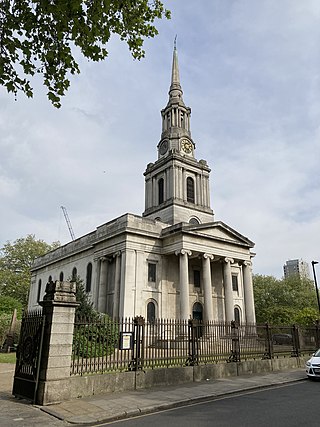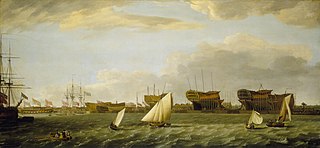
Poplar is a district in East London, England, now part of the London Borough of Tower Hamlets. Five miles (8 km) east of Charing Cross, it is part of the East End.

Bromley, commonly known as Bromley-by-Bow, is a district in the London Borough of Tower Hamlets in East London, located on the western banks of the River Lea, in the Lower Lea Valley in East London.

Poplar was a local government district in the metropolitan area of London, England. It was formed as a district of the Metropolis in 1855 and became a metropolitan borough in the County of London in 1900. It comprised Poplar, Millwall, Bromley-by-Bow and Bow as well as Old Ford, Fish Island and Cubitt Town.

The Lansbury Estate is a large, historic council housing estate in Poplar and Bromley-by-Bow in the London Borough of Tower Hamlets. It is named after George Lansbury, a Poplar councillor and Labour Party MP.

St Matthias Old Church is the modern name given to the Poplar Chapel built by the East India Company in 1654, in Poplar. The church is designated a Grade II* listed building.

Blackwall is an area of Poplar, in the London Borough of Tower Hamlets, East London. The neighbourhood includes Leamouth and the Coldharbour conservation area.
The North London Railway (NLR) company had lines connecting the northern suburbs of London with the East and West India Docks further east. The main east to west route is now part of London Overground's North London Line. Other NLR lines fell into disuse but were later revived as part of the Docklands Light Railway, and London Overground's East London Line. The company was originally called the East & West India Docks & Birmingham Junction Railway (E&WID&BJR) from its start in 1850, until 1853. In 1909, it entered into an agreement with the London and North Western Railway which introduced common management, and the NLR was taken over completely by the LNWR in 1922. The LNWR itself became part of the LMS from the start of 1923. The railways were nationalised in 1948 and most LMS lines, including the North London route, then came under the control of the London Midland Region of British Railways.

Bow is an area of east London, England, within the London Borough of Tower Hamlets, 4.6 miles (7.4 km) east of Charing Cross.

Leamouth is a locality in the Blackwall area of Poplar, in the London Borough of Tower Hamlets. The area takes its name from the former Leamouth Wharf and lies on the west side of the confluence of the Bow Creek stretch of the Lea, at its confluence with the River Thames.

William Hosking was an English writer, lecturer, and architect who had an important influence on the growth and development of London in Victorian times. He became the first Professor of Architecture at King's College London, and associated this discipline in a scholarly fashion with interests in town planning, civil engineering, history and antiquities.

All Saints Church, Poplar, is a church in Newby Place, Poplar, London Borough of Tower Hamlets, and is the Church of England parish church of Poplar. It was built in 1821–3 to serve the newly created parish.
South Bromley railway station was a former railway station in South Bromley, London, on the North London Railway between Bow and Poplar. It opened in 1884 but was closed in 1944 after bomb damage in the Blitz cut off the railway east of Dalston Junction.
Poplar (East India Road) was a railway station located on the East India Dock Road in Poplar, London. It was opened in 1866 by the North London Railway. It was the southern passenger terminus of the NLR, although goods trains ran on to connect to the London and Blackwall Railway (LBR) for the East India Docks or to the LBR's Millwall Extension Railway for the West India Docks.

Blackwall Yard is a small body of water that used to be a shipyard on the River Thames in Blackwall, engaged in ship building and later ship repairs for over 350 years. The yard closed in 1987.

Coldharbour is a street and wider conservation area in Blackwall, lying on the north bank of the River Thames, east of Canary Wharf. The area is said to be "[t]he sole remaining fragment of the old hamlet of Blackwall" and "one of the last examples of the narrow streets which once characterised the river's perimeter".

George Green was a ship builder from Blackwall, London.

John Perry was the founder of the Blackwall Yard, where he built ships largely for the East India Company.

East India Dock Road is a major arterial route from Limehouse to Canning Town in London. The road takes its name from the former East India Docks in the Port of London. To the west it becomes Commercial Road and to the east Newham Way. It forms part of the A13, a major road connecting the historic City of London to Tilbury and Southend.
Sir Henry Johnson was an English shipbuilder and politician who sat in the House of Commons in 1679. He was one of the leading commercial shipbuilders on the River Thames during the period of enormous mercantile expansion and the Dutch wars after the Restoration..

Mayflower Primary School is a primary school in the Poplar area of East London in the London Borough of Tower Hamlets. Originating in 1843 and formerly called Upper North Street School, it was badly damaged in an air raid in 1917 during the First World War, resulting in the deaths of eighteen children. The school was rebuilt in 1928 and adopted its present name in 1952. The school was judged to be "outstanding" at an Ofsted inspection in 2017, and was awarded the title "Primary School of the Year" in 2020 by a national newspaper.


















